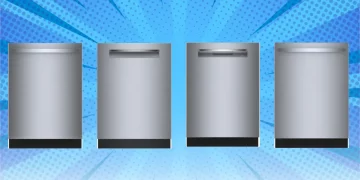Discover the best small and compact dishwashers. Expert tips for choosing the perfect model for your needs and budget.
Sick of hand-washing mountains of dirty dishes? Dreaming of freeing up your precious counter space? A compact dishwasher can be a total game changer. But not all dishwashers are created equal. You want one that fits your space, matches your lifestyle, and doesn’t disrupt the peace. So before you hit purchase, let me spill some insider home appliance knowledge. We’ve helped thousands of people find their dishwasher soulmate. In this guide, I’ll walk you through:
- The best dishwashers for small spaces
- Key features to consider so you pick the perfect model for YOUR needs
- Savvy tips to keep your new dishwasher running like new
- Genius loading tricks for spotless dishes every time
Trust me, the suitable small dishwasher will save you time, stress, and arguments over whose turn to load the sink. So read on for advice you won’t find in the manuals!
Key Considerations When Buying a Small Dishwasher
Intended Use and Capacity Needs
The first step is identifying your household’s unique dishwasher needs. Will this be your primary dish-cleaning method or a supplementary option alongside hand washing? Consider your average load size and how many place settings you require. Compact 18-inch dishwashers accommodate around 8 place settings, while standard 24-inch models reach 16. Countertop dishwashers are incredibly convenient space savers, but their capacity maxes out around 6 place settings. Measure your space’s dimensions and entryways to ensure your new dishwasher will fit. I’ve had customers realize too late that their cabinet opening was slightly too narrow!
Installation Type
Small dishwashers come in portable, countertop, and built-in versions. Portable units have wheels and are the easiest to install by simply plugging into an outlet. They can also be stored out of sight when not in use. Countertop dishwashers are designed for placement on your kitchen counter. They connect via quick-connect adapters to your sink’s faucet for water supply and drainage. These are pretty easy to DIY install. Built-in models are designed to integrate seamlessly into your cabinetry for a sleek custom look. However, installing them yourself requires precise measurement and some carpentry skills. Built-ins may also require custom panels to match your existing cabinet faces. I recommend hiring a professional installer for a frustration-free experience.
Cycle Options
The cycle presets optimize wash performance for different levels of soiling. At a minimum, look for Normal, Heavy, and Rinse cycles. Quick washes are convenient for lightly soiled loads when you’re short on time. Extra cycles like Steam, Sanitize, and Dry Boost use smart technology to loosen stuck-on food, eliminate bacteria, and thoroughly dry every item. I’m a huge fan of air-dry dishwashers, which gently circulate air for spotless results without relying solely on heat elements.
Noise Level
Dishwasher operation volume is measured in decibels (dB). Standard models run around 50 dB, which is about the volume of a normal conversation. Look for 40-45 dB for an ultra-quiet performance suitable for open floor plans. Insulation technologies like sound-absorbing bases and internal spray arm covers result in that blissful silence.
Efficiency
Water—and energy-efficient dishwashers help lower utility bills while reducing environmental impact. Look for the Energy Star Most Efficient certification. Features like soil sensors, filter systems, and precision spray arms target washing power only where needed, optimizing water and electricity usage.
Smart Home Integration
For tech-savvy households, Wi-Fi-enabled dishwashers can be controlled remotely via smartphone. You can monitor cycle status, receive end-of-cycle alerts, and schedule cleaning. Models with internal cameras even let you view the dishwasher’s contents!
Reliability and Warranties
It’s worthwhile investing in a durable dishwasher built by a reputable brand that stands behind its products with good warranty coverage. Look for at least a one-year full warranty. High-end brands often include 5-10 years of coverage for the wash system. Extended warranties are also available for added peace of mind. Before purchasing, read the fine print on which parts and services are covered.
Helpful Tips for Maintaining Your Dishwasher
To keep your new dishwasher running at peak performance for years to come, here are my top tips for maintenance and care:
Clean the Filters Regularly
Food particles and grease easily get trapped in your dishwasher’s filters if they are not cleaned. I recommend removing and rinsing the cylindrical filter inside the bottom rack about once a month and scrubbing the fine mesh filter on the bottom with a toothbrush every three months.
Use a Dishwasher Cleaner Monthly
Over time, grease and mineral deposits can build up inside the spray arms, hoses, and other internal parts. Using a dishwasher cleaner monthly helps remove this grime. Place the cleaner tablet in an empty dishwasher and cycle normally. It’s like a deep clean for your appliance!
Wipe Away Exterior Buildup
If you notice soap scum or water spots accumulating on the outside, wipe the door and seal it with a damp microfiber cloth to keep your dishwasher looking its best. I like using equal parts vinegar and water for a natural cleaning solution.
Air Dry the Interior
To prevent musty odors, prop the door open after cycles to allow the interior to air dry fully. To maintain freshness, you can also run an empty Normal cycle with the Heat Dry option once a week.
Inspect the Rinse Aid Dispenser
The rinse aid helps prevent spots and streaks. Check the dispenser monthly to ensure it is adequately filled. Refill it with rinse aid as needed, and clean out any residue buildup with a small brush.
Descale as Needed
In areas with hard water, mineral deposits can accumulate over time and clog your dishwasher’s jets, hoses, and pump. Descale annually or more often if you notice low water pressure or cloudy results. Use citric acid or vinegar.
Replace Old Detergent and Rinse Aid
To avoid poor washing results, replace dishwasher detergent and rinse aids over three months old. The chemicals degrade over time. Store these products in a cool, dry place to maximize freshness.
Helpful Loading Tips
The way you load your dishes can majorly impact cleaning performance. Here are my top tips:
Scrape Off Excess Food
It’s best to scrape large food pieces into the trash before loading dishes. This prevents the filter from clogging. The wash jets target surface-level soils, not large chunks.
Position Items Strategically
Place items like bowls, pots, and platters around the edge, with soiled surfaces facing inward to meet the water spray head. For maximum exposure, put plastics on the top rack and utensils in either the cutlery basket or the third rack.
Avoid Nesting Items
Nesting bowls or placing utensils in cups can block water from reaching all surfaces. Remember to separate stacked items and spread them out.
Angle Utensils Downward
Point knife blades, spoon bowls, and fork tines downward so water drains off efficiently. This prevents pooling, which can leave spots.
Don’t Overload
Crowding your dishwasher decreases cleaning performance. Make sure water can circulate freely in all areas. For best results, load evenly but loosely. I hope these buying considerations, maintenance tips, and loading tricks help you select the perfect small dishwasher for your needs! Let me know if you have any other questions.













